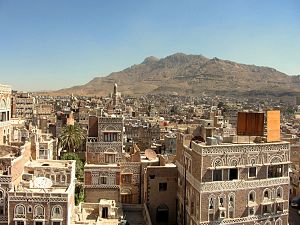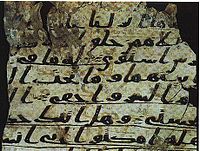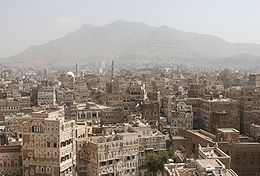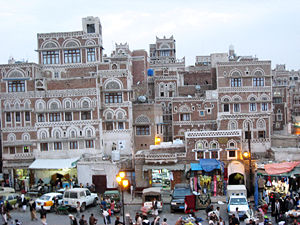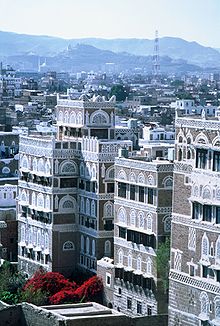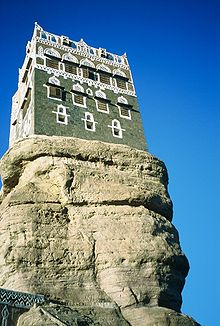- Sana'a
-
This article is about the capital of Yemen. For other uses, see Sanaa (disambiguation).
Sana'a
صنعاء ṢanʿāʾSana'a Location in Yemen Coordinates: 15°20′54″N 44°12′23″E / 15.34833°N 44.20639°ECoordinates: 15°20′54″N 44°12′23″E / 15.34833°N 44.20639°E Country  Yemen
YemenAdministrative division Amanat Al Asimah Government – Type Local – Mayor: Abdulrahman al-Akwaa Numan Dowaid Elevation 7,382 ft (2,250 m) Population (2004) – City 1,747,627 – Metro 2,167,961 Time zone GMT+3 Sana'a (Arabic: صنعاء Ṣanʿāʾ pronounced [sˤɑnʕaːʔ], Yemeni Arabic: [ˈsˤɑnʕɑ]), also spelled "Sanaa", is the capital of Yemen and the centre of San‘a’ Governorate; however the city itself is not part of the Governorate, but forms the separate administrative district of "Amanat Al-Asemah".
Sana'a is one of the oldest continuously inhabited cities in the world. At an altitude of 2,300 metres (7,500 ft), it is also one of the highest capital cities in the world. Sana'a has a population of approximately 1,748,000 (2010) making it Yemen's largest city. The old city of Sana'a, a UNESCO World Heritage Site, has a distinctive visual character due its unique architectural characteristics, most notably expressed in its multi-story buildings decorated with geometric patterns.[1] [2]
Contents
History
Sana'a is one of the oldest populated places in the world. According to popular legend it was founded by Shem, the son of Noah. [3][4] It was known as "Azal" in ancient times, referring to Uzal, a son of Qahtan who was a great-grandson of Shem. Its current name likely derived from the South Arabian word for "well-fortified." Arab historian al-Hamdani wrote that Sana'a was walled by the Sabeans under their ruler Sha'r Awtar who also built the Ghumdan Palace in the city. Because of its location, Sana'a has served as an urban center for the surrounding tribes of the region and as a nucleus of regional trade in southern Arabia. It was positioned at the crossroad of two major ancient trade routes linking Marib in the east to the Red Sea in the west.[4]
When King Yousef Athar (or Dhu Nuwas), the last of the Himyarite kings, was in power, Sana'a was also the capital of the Ethiopian viceroys.
As of the dawn of Islam until the detachment of independent sub-states in many parts of Yemen Islamic Caliphate, Sana'a persisted as the governing seat, who himself is Caliph's deputy in running the affairs of one of Yemen's Three Makhalifs: Mikhlaf Sana'a, Mikhlaf al-Janad and Mikhlaf Hadhramawt. The city of Sana'a recurrently assumed an important status and all Yemenite States competed to control it.
The Mamelukes arrived in Yemen in AD 1517. Following the collapse of the Mamelukes in Egypt at the hands of the Ottoman Turks, Yemen fell under the Ottoman rule and during the first Ottoman rule of Yemen between 1538–1635, Sana'a became the capital of the Ottoman wilayah and also during the Ottoman second rule 1872-1918. In 1918, Sana'a was the capital of Imam Yahya, who ruled North Yemen. At the onset of the 1962 revolution which deposed the imamate rule, it became the capital of the Yemen Arab Republic. It was then the capital of unified Yemen in 1990 where it is dubbed as the historical capital of Yemen. In 2008, the Saleh Mosque was completed. It holds over 40,000 worshippers.
Old City of Sana'a * UNESCO World Heritage SiteCountry Yemen Type Historic, Cultural Criteria IV, V, VI Reference 385 Region ** Arab States Inscription history Inscription 1986 (10th Session) * Name as inscribed on World Heritage List
** Region as classified by UNESCODistricts
- Al Wahdah District
- As Sabain District
- Assafi'yah District
- At Tahrir District
- Ath'thaorah District
- Az'zal District
- Bani Al Harith District
- Ma'ain District
- Old City District
- Shu'aub District
Main sights and culture
Old City
The old fortified city has been inhabited for more than 2,500 years and contains a wealth of intact architectural gems. It was declared a World Heritage Site by the United Nations in 1986. Efforts are underway to preserve some of the oldest buildings, some of which, such the Samsarh and the Great Mosque of Sana'a, are more than 1400 years old. Surrounded by ancient clay walls which stand 9–14 metres (30–46 ft) high, the old city contains more than 100 mosques, 12 hammams (baths) and 6,500 houses. Many of the houses resemble ancient skyscrapers, reaching several stories high and topped with flat roofs. They are decorated with elaborate friezes and intricately carved frames and stained-glass windows.
One of the most popular attractions is Suq al-Milh (Salt Market), where it is possible to buy not only salt but also bread, spices, raisins, cotton, copper, pottery, silverware, and antiques. The majestic 7th-century Jami' al-Kabir (Great Mosque) is one of the oldest in the Muslim world. The Bāb al-Yaman (Yemen Gate) is an iconized entry point through the city walls and is more than 1000 years old. Nearby is Tahreer Square, also known as Freedom Square or Change Square, which has been the site of protests and where Nobel Peace Prize winner Tawakel Karman has been camped in a tent throughout the Arab Spring movement.
A commercial area of the old city is Al Madina, where development is proceeding rapidly. In addition to three large hotels, there are numerous stores and restaurants. The area also contains three parks and the President's palace.
Arab Cultural Capital
Sana'a was designated as the Arab Cultural Capital for the year of 2004.
Demographic evolution
Year Population 1911 20,000 1921 23,000 1931 25,000 1940 80,000 1963 100,000 1965 110,000 Year Population 1975 134,600 1981 280,000 1986 427,505 1994 954,448 2001 1,590,624 2005 1,937,451 Sana'a is the fastest growing capital city in the world with a growth rate of 7%,[5] while the growth rate of the nation as a whole is 3.2%.[6] If the current rate is maintained, the population of Sana'a will double in ten years. The majority of this increase is due to rural to urban migration for employment.
Jewish community
Jews have been present in Yemen since the days of King Solomon and form one of the most historic Jewish diasporas. After the creation of the state of Israel about 49,000 (of an estimated 51,000) of Yemeni Jews were airlifted to Israel, almost 10,000 of which were from Sana'a (see the English-language book Jews and Muslims in lower Yemen: a study in protection and restraint, 1918-1949). There was essentially no Jewish population in Sana'a until the Sa'dah insurgency broke out in Saada Governorate in 2004. The Houthi rebels directly threatened the Jewish community in 2007, prompting the government of President Saleh to offer them refuge in Sana'a. As of 2010, there were around 70 Jews living in the capital under government protection.[7]
Economy
As the capital city of Yemen, 40% of jobs in Sana'a are in the public sector. Other primary sources of formal employment in the city are trade and industry. Like many other cities in the developing world, Sana'a has a large informal sector which is estimated to constitute 32% of nongovernmental employment. However, while there are a greater variety of jobs in Sana'a as compared to other cities in Yemen, there is also greater poverty and unemployment. It is estimated that 25% of the labor force in Sana'a is unemployed.[8]
Transport
Yemenia, the national airline of Yemen, has its head office in Sana'a.[9] Sana'a International Airport is Yemen's main domestic and international airport. There is currently no rail network but there are plans to install one in the future. A primary means of transport in the city is via dababs, minibuses which carry about 10 people. Taxis are also a very common form of public transport and there are coaches to major cities such as Aden and Taiz.
Quotes and impressions
"La budda min Ṣanʻāʼ" (Sana'a must be seen) are famous words first attributed to Imam Muḥammad ibn Idris al-Shafiʼi (768-820) who visited the ancient capital several times.
Many travellers in ancient days were impressed by the beauty of Sana'a. The well-known Yemeni geographer and historian al Hamdani marveled at the cleanliness of the city:
“ The least dwelling there has a well or two, a garden and long cesspits separate from each other, empty of ordure, without smell or evil odors, because of the hard concrete (adobe and Cob probably) and fine pastureland and clean places to walk. ” The Persian traveller Ibn Rustah, a contemporary of al-Hamdani, noted its food:
“ It is the city of Yemen - there not being found ... a city greater, more populous or more prosperous, of nobler origin or more delicious food than it... ” The British writer Jonathan Raban devotes a chapter of his 1979 book, 'Arabia Through the Looking Glass' to Sana'a. He initially found the city disorienting:
“ Suddenly in Sana'a I was in the middle of a real maze. Its walls were oppressively high, its corridors narrow, its noise frightening. ... Sana'a was functioning exactly as a labyrinth should: it was a close protective hive for insiders; but for an outsider it was a trap with no apparent means of escape. ” Later, as he became more familiar with the place, and had made more acquaintances with its residents, he becomes admiring. In one striking sequence where he is invited onto the roof of somebody's home, the cityscape is revealed to him in a different way:
“ It was like stepping out into the middle of a vast pop-up picturebook. Away from the street, the whole city turned into a maze of another kind, a dense, jumbled alphabet of signs and symbols. The stucco friezes on the towers formed a continuous scrawl of handwriting around. You could look at the walls of Sana'a for a year, finding more and more hidden meanings in them. ” Climate
Sana'a features the very rare mild version of a desert climate. Sana'a sees on average approximately 200 mm of precipitation per year. However, due to its high elevation, temperatures are much more moderate than many other cities on the Arabian Peninsula. In fact, average temperatures remain relatively constant throughout the year in Sana'a, with its coldest month being January and its warmest month in July. The city seldom experiences extreme heat or cold. However, some areas around the city can see temperatures fall to around 15 or 20 degrees Fahrenheit during winter. Frost usually occurs in the early winter mornings, and there is a slight wind chill in the city that causes the cold mornings to be oddly bitter. The Sun warms the city to the 60s during the noontime but it drops drastically as night falls in. Sana'a receives half of its annual rainfall during the months of July and August. Rainfall comes depending on the year; some years could see 500–600 mm of rainfall, while others can barely get 150 mm. High temperatures have increased slightly during the summer over the past few years, however, low temperatures and winter temperatures have dramatically fallen over the same period
Climate data for Sana'a (2250 m) Month Jan Feb Mar Apr May Jun Jul Aug Sep Oct Nov Dec Year Average high °C (°F) 19.8
(67.6)20.2
(68.4)22.8
(73.0)25.5
(77.9)26.0
(78.8)27.1
(80.8)27.7
(81.9)25.9
(78.6)23.7
(74.7)22.0
(71.6)20.7
(69.3)19.7
(67.5)23.43
(74.17)Average low °C (°F) 5.1
(41.2)8.0
(46.4)9.7
(49.5)11.5
(52.7)13.6
(56.5)15.8
(60.4)16.7
(62.1)16.3
(61.3)12.4
(54.3)9.1
(48.4)6.8
(44.2)6.2
(43.2)10.93
(51.68)Precipitation mm (inches) 0.0
(0)2.0
(0.079)9.9
(0.39)14.7
(0.579)4.7
(0.185)17.8
(0.701)49.9
(1.965)63.6
(2.504)24.0
(0.945)7.5
(0.295)4.4
(0.173)0.0
(0)198.5
(7.815)Source: National Weather Service Sport
The city is home to the Ali Muhesen Stadium, home of the Yemen national football team, and is mostly used for football and cricket matches. The stadium holds 25,000 people.
Although Yemen was the host nation of the Gulf Cup of Nations in 2010, Sana'a was not a host city. The games were held rather in the Aden and Abyan governates.
See also
- Mahwa Aser
- Al Khair Mosque
- Sana'a manuscripts – fragments from over 1000 early Qur'an codices, discovered at the Great Mosque in Sana'a in 1972.
- Saleh Mosque
- 2011 Yemeni protests
References
- ^ Young, T. Luke. "Conservation of the Old Walled City of Sana'a Republic of Yemen". MIT. http://web.mit.edu/akpia/www/AKPsite/4.239/sanaa/yemen.html.
- ^ Anna Hestler; Jo-Ann Spilling (1 January 2010). Yemen. Marshall Cavendish. p. 16. ISBN 9780761448501. http://books.google.com/books?id=JNJiTaTaEocC&pg=PA16. Retrieved 23 November 2010.
- ^ Marchand, p.1.
- ^ a b Aithe, p.30.
- ^ "Sana'a running out of water with no plan to save it". The Global Urbanist. http://globalurbanist.com/2010/03/23/sana%27a-running-out-of-water-with-no-plan-to-save-it.aspx. Retrieved March 23, 2010.
- ^ "At a glance: Yemen - Statistics". UNICEF. http://www.unicef.org/infobycountry/yemen_statistics.html.
- ^ Persecuted Yemeni Jews to be given sanctuary in Britain, The Independent, 14 April 2010.
- ^ "Sana'a, A City Development Strategy". The Cities Alliance. 2006.
- ^ "Yemenia." Arab Air Carriers Organization. Retrieved on 26 October 2009.
External links
- "The Old Walled City of San`a", 113 page book by Ronald Lewcock for Unesco
- "Sana'a - City of lights. The German-French Cultural Project 2007. Weblog"
- Eric Hansen, Sana'a rising, Saudi Aramco World, 2006. Vol. 57 No. 1
- Tim Mackintosh-Smith, The Secret Gardens of Sana'a. Saudi Aramco World, 2006 Vol. 57 No. 1
- Traditional housing in the old quarter of Sanaa in 1972
Governorates of Yemen 
 Sana'a GovernorateCapital: Sana'a
Sana'a GovernorateCapital: Sana'aDistricts Al Haymah Ad Dakhiliyah District • Al Haymah Al Kharijiyah District • Al Husn District • Arhab District • Attyal District • Bani Dhabyan District • Bani Hushaysh District • Bani Matar District • Bilad Ar Rus District • Hamdan District • Jihanah District • Khwlan District • Manakhah District • Nihm District • Sa'fan District • Sanhan DistrictCapitals of Arab countries Africa Asia - Cairo 1996 (Egypt)
- Tunis 1997 (Tunisia)
- Sharjah 1998 (United Arab Emirates)
- Beirut 1999 (Lebanon)
- Riyadh 2000 (Saudi Arabia)
- Kuwait 2001 (Kuwait)
- Amman 2002 (Jordan)
- Rabat 2003 (Morocco)
- San'a 2004 (Yemen)
- Khartoum 2005 (Sudan)
- Muscat 2006 (Oman)
- Algiers 2007 (Algeria)
- Damascus 2008 (Syria)
- Jerusalem 2009 (Jerusalem)
- Doha 2010 (Qatar)
- Sirte 2011 (Libya)
- Manama 2012 (Bahrain)
- Baghdad 2013 (Iraq)
Categories:- Arab Capital of Culture
- Sana'a
- Populated places in Sana'a Governorate
- Capitals in Asia
- World Heritage Sites in Yemen
- Red Sea
- Aga Khan Award for Architecture winners
- Archaeological sites in Yemen
Wikimedia Foundation. 2010.

